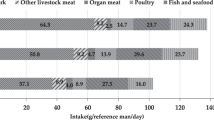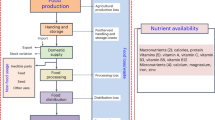Abstract
Nutrition and health care are the most efficient and cost-effective ways to promote growth and prevent diseases. The dramatic decrease in the prevalences of stunting and malnutrition in China is the result of rapid economic development and nutrition efforts. The improvement in the Chinese populations’ overall health status is consistent with the United Nation Sustainable Development Goal of “ending hunger, achieving food security and improving nutrition.” Recent healthy policies, such as “Outline of the Healthy China 2030 Plan” and “Healthy China Action Plan (2019–2030),” pivot the shift from medical care to nutrition and health promotion, which sets a series of actions and goals that point out direction to China’s nutrition policy improvement in the next decade. This paper systematically summarizes the China’s nutrition policy environment and governance, implementation and actions of a series of food and nutrition policies, as well as available professional development and public education relevant to the field of nutrition. The challenges and prospects of nutrition actions are also addressed to pave a path for future policy-making and better nutrition improvements to successfully achieve Healthy China 2030.
This is a preview of subscription content, access via your institution
Access options
Subscribe to this journal
Receive 12 print issues and online access
$259.00 per year
only $21.58 per issue
Buy this article
- Purchase on Springer Link
- Instant access to full article PDF
Prices may be subject to local taxes which are calculated during checkout

Similar content being viewed by others
References
FAO, WHO. World declaration and plan of action for nutrition. FAO, WHO, Rome; 1992.
Disease Prevention and Control Bureau of National Health and Family Planning Commission of China. Report on nutrition and chronic diseases of Chinese residents. People’s Medical Publishing House, Beijing; 2015.
International Food Policy Research Institute. Global Nutrition Report-Shining a light to spur action on nutrition. International Food Policy Research Institute. Global Nutrition Report, UK. 2018.
Ministry of Health of the People’s Republic of China. Report on Chinese 0-6 years old child nutrition development (2012). Ministry of Health of the People’s Republic of China, Beijing; 2012.
WHO. Global nutrition policy review 2016–2017. WHO, Geneva, Switzerland; 2018.
Yang Y, Ge K. Encyclopedia of nutrition science. People’s Medical Publishing House, Beijing; 2019.
Zhou M, Wang H, Zeng X, Yin P, Zhu J, Chen W, et al. Mortality, morbidity, and risk factors in China and its provinces, 1990-2017: a systematic analysis for the Global Burden of Disease Study 2017. Lancet. 2019;394:1145–58.
Mozaffarian D, Angell SY, Lang T, Rivera JA. Role of government policy in nutrition-barriers to and opportunities for healthier eating. BMJ. 2018;361:k2426.
Lamstein S, Pomeroy-Stevens A, Webb P, Kennedy E. Optimizing the multisectoral nutrition policy cycle: a systems perspective. Food Nutr Bull. 2016;37:S107–14.
The State Council of China. China Nutrition Improvement Action Plan (1996-2000). The State Council of China, Beijing; 1997.
Chen WW, Gao RL, Liu LS, Zhu ML, Wang W, Wang YJ, et al. China cardiovascular diseases report 2015: a summary. J Geriatr Cardiol. 2017;14:1–10.
Fu W, Zhao S, Zhang Y, Chai P, Goss J. Research in health policy making in China: out-of-pocket payments in Healthy China 2030. BMJ. 2018;360:k234.
The State Council of China. Outline of the Healthy China 2030 Plan. The State Council of China, Beijing; 2016.
The State Council of China. Healthy China Action Plan (2019–2030). The State Council of China, Beijing; 2019.
Lu Y, Nakicenovic N, Visbeck M, Stevance AS. Policy: five priorities for the UN Sustainable Development Goals. Nature. 2015;520:432–3.
Tan X, Liu X, Shao H. Healthy China 2030: a vision for health care. Value Health Reg Issues. 2017;12:112–4.
He Y, Zhao W, Zhang J, Zhao L, Yang Z, Huo J, et al. Data resource profile: China National Nutrition Surveys. Int J Epidemiol. 2019;48:368.
The Ministry of Agriculture and other departments. China Food and Nutrition Development Outline (2001–2010). The Ministry of Agriculture and other departments, Beijing; 2001.
The Ministry of Agriculture and other departments. China Food and Nutrition Development Outline (2014–2020). The Ministry of Agriculture and other departments, Beijing; 2014.
The State Council of China. The National Medium and Long-term Scientific and Technological Development Outline (2006–2020). The State Council of China, Beijing; 2006.
The Ministry of Health of China. Management Measures for Nutrition Improvement. The Ministry of Health of China, Beijing; 2010.
The Ministry of Health of China and other departments. Chinese Chronic Disease Prevention and Control Work Plan (2012–2015). The Ministry of Health of China and other departments, Beijing; 2012.
The State Council of China. National Nutrition Plan (2017–2030). The State Council of China; 2017.
Chen P, Li F, Harmer P. Healthy China 2030: moving from blueprint to action with a new focus on public health. Lancet Public Health. 2019;4:e447.
Wang L, Wang Z, Ma Q, Fang G, Yang J. The development and reform of public health in China from 1949 to 2019. Glob Health. 2019;15:45.
Li X, Lu J, Hu S, Cheng KK, De Maeseneer J, Meng Q, et al. The primary health-care system in China. Lancet. 2017;390:2584–94.
Yang L, Sun L, Wen L, Zhang H, Li C, Hanson K, et al. Financing strategies to improve essential public health equalization and its effects in China. Int J Equity Health. 2016;15:194.
Tian M, Wang H, Tong X, Zhu K, Zhang X, Chen X. Essential public health services’ accessibility and its determinants among adults with chronic diseases in China. PLoS ONE. 2015;10:e125262.
Hu W, Shen X. The international experience of students nutrition improvement program and its inspiration to the nutrition practitioners in China. J Biol Educ. 2015;3:48–52.
Huo J, Sun J, Fang Z, Chang S, Zhao L, Fu P, et al. Effect of home-based complementary food fortification on prevalence of anemia among infants and young children aged 6 to 23 months in poor rural regions of China. Food Nutr Bull. 2015;36:405–14.
Scherpbier RW. China’s progress and challenges in improving child nutrition. Biomed Environ Sci. 2016;29:163–4.
Wu Q, van Velthoven MH, Chen L, Car J, Rudan D, Saftic V, et al. Improving the intake of nutritious food in children aged 6-23 months in Wuyi County, China—a multi-method approach. Croat Med J. 2013;54:157–70.
Miller LM, Cassady DL. The effects of nutrition knowledge on food label use. A review of the literature. Appetite. 2015;92:207–16.
Kasapila W, Shaarani SM. Legislation-impact and trends in nutrition labeling: a global overview. Crit Rev Food Sci Nutr. 2016;56:56–64.
The Ministry of Health of China. General Rules for Nutrition Labeling of Prepackaged Foods (GB28050-2011). Beijing: China Standard Press; 2011.
WHO. Guideline: sodium intake for adults and children. Geneva: World Health Organization; 2012.
Asaria P, Chisholm D, Mathers C, Ezzati M, Beaglehole R. Chronic disease prevention: health effects and financial costs of strategies to reduce salt intake and control tobacco use. Lancet. 2007;370:2044–53.
WHO. The salt habit, the SHAKE technical package for salt reduction. WHO, Geneva, Switzerland; 2016.
Hipgrave DB, Chang S, Li X, Wu Y. Salt and sodium intake in China. JAMA. 2016;315:703–5.
National Institute for Nutrition and Health of China CDC and Chinese Nutrition Society. Guidelines for salt reduction in Chinese food industry. People’s Medical Publishing House, Beijing, 2019.
Chinese Nutrition Society. Labeling specification for healthier choice in prepackaged food. Chinese Nutrition Society, Beijing; 2018.
Kanter R, Vanderlee L, Vandevijvere S. Front-of-package nutrition labelling policy: global progress and future directions. Public Health Nutr. 2018;21:1399–408.
Cecchini M, Sassi F, Lauer JA, Lee YY, Guajardo-Barron V, Chisholm D. Tackling of unhealthy diets, physical inactivity, and obesity: health effects and cost-effectiveness. Lancet. 2010;376:1775–84.
Mozaffarian D, Rosenberg I, Uauy R. History of modern nutrition science-implications for current research, dietary guidelines, and food policy. BMJ. 2018;361:k2392.
Herforth A, Arimond M, Alvarez-Sanchez C, Coates J, Christianson K, Muehlhoff E. A global review of food-based dietary guidelines. Adv Nutr. 2019;10:590–605.
Ayala A, Meier BM. A human rights approach to the health implications of food and nutrition insecurity. Public Health Rev. 2017;38:10.
Li X, Song J, Lin T, Dixon J, Zhang G, Ye H. Urbanization and health in China, thinking at the national, local and individual levels. Environ Health. 2016;15:32.
Zhang B, Yang Y. Thinking on nutrition problems and countermeasures in China. Acta Nutrimenta Sinica. 2015;37:7–12.
Popkin BM. Relationship between shifts in food system dynamics and acceleration of the global nutrition transition. Nutr Rev. 2017;75:73–82.
Wang Y, Wang L, Qu W. New national data show alarming increase in obesity and noncommunicable chronic diseases in China. Eur J Clin Nutr. 2017;71:149–50.
Author information
Authors and Affiliations
Corresponding author
Ethics declarations
Conflict of interest
The authors declare that they have no conflict of interest.
Additional information
Publisher’s note Springer Nature remains neutral with regard to jurisdictional claims in published maps and institutional affiliations.
Rights and permissions
About this article
Cite this article
Gao, C., Xu, J., Liu, Y. et al. Nutrition Policy and Healthy China 2030 Building. Eur J Clin Nutr 75, 238–246 (2021). https://doi.org/10.1038/s41430-020-00765-6
Received:
Revised:
Accepted:
Published:
Issue Date:
DOI: https://doi.org/10.1038/s41430-020-00765-6
This article is cited by
-
Protocol of a parallel, randomized controlled trial on the effects of a novel personalized nutrition approach by artificial intelligence in real world scenario
BMC Public Health (2023)
-
An effective method for the protection of user health topic privacy for health information services
World Wide Web (2023)
-
Perceived social support and diet quality among ethnic minority groups in Yunnan Province, Southwestern China: a cross-sectional study
BMC Public Health (2021)
-
RETRACTED ARTICLE: The spatial effect of Nanjing’s fitness strategy: considering citizens’ fitness status
Arabian Journal of Geosciences (2021)



